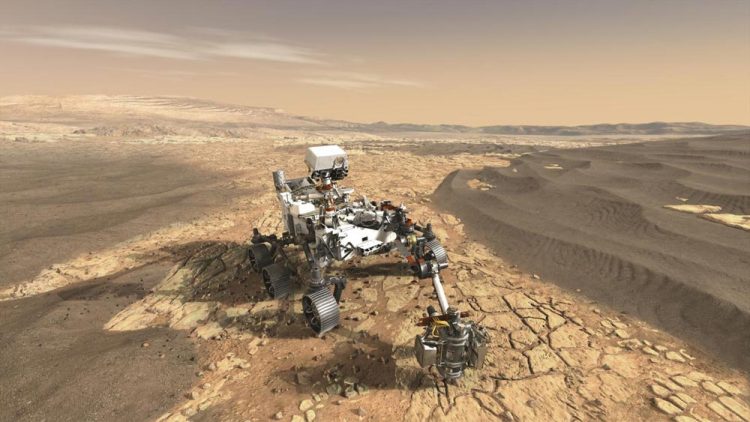Mars 2020 mission to use smart methods to seek signs of past life

This is a conceptual image of the Mars 2020 rover. Credit: NASA/JPL-Caltech
Speaking at the Goldschmidt conference in Paris where he is presenting the methods to be adopted, Dr Ken Williford (who is also Director of the Jet Propulsion Laboratory's Astrobiogeochemistry Laboratory) said:
“Previous missions to Mars have used a relatively broad brush – analyzing average chemistry over roughly the size of a postage stamp – to “follow the water” and seek ancient habitable environments. Mars 2020 takes the next natural step in its direct search for evidence of ancient microbial life, focusing measurements to the microbial scale and producing high-resolution maps over similarly postage stamp-sized analytical areas.
New scientific methods for searching for the most ancient evidence for life on Earth have led to a leap forward in capabilities for biosignature detection. Rather than using “bulk” geochemistry techniques that measure the average composition of a rock, Mars 2020 is developing new capabilities including X-ray fluorescence and Raman spectroscopy to map the elemental, mineral, and organic composition of rocks at high spatial resolution, with analytical spot sizes about the width of a human hair. Understanding the spatial distribution of chemical features preserved in ancient rocks is key to determining whether or not they were formed by life.
Beyond astrobiology, these new techniques enable exploration of the planet Mars at telescopic to microscopic scales – from a mountain to a grain of sand.”
The instruments in development for Mars 2020 have roots in the search for the earliest signs of life on Earth, as well as life in extreme environments – deep underground, or in hydrothermal settings along ocean-floor ridges. When these methods have been applied on Earth they have enabled scientists to lower limits of detection or to better understand formerly ambiguous observations.
In addition, the Mars 2020 mission will use the knowledge gained from its scientific exploration to select and collect key samples that could one day be examined in laboratories back on Earth. Thirty to forty rock and sediment core samples, each about 15 grams, will be hermetically sealed in titanium tubes and deposited in a safe location on the surface of Mars for possible retrieval by a future mission.
“Mars 2020 represents a crucial first step towards a possible Mars sample return. Our objective is to collect a diverse set of samples from our landing site with the best potential to preserve records of the evolution of Mars – including the presence of life if it was there. We'll use our onboard instruments to provide the critical field context that future scientists would need to understand the measurements made back on Earth.”
Dr Williford also discussed the three remaining candidate landing sites for the Mars 2020 mission. One site at Columbia Hills in Gusev crater, was visited previously by the Spirit rover and features silica deposits interpreted by some as analogous to hydrothermal springs known to be inhabited on Earth. The two other sites are located close together on the edge of Isidis Planitia, one of the largest (and oldest) impact craters in the Solar System. Northeast Syrtis features some of the oldest exposed Martian crust with evidence for alteration in the presence of liquid water that leads researchers to believe that this site could have hosted subsurface life. Jezero crater features an ancient river delta and a lake that could have been a prime location for life on early Mars.
“We've got some hard decisions in front of us,” Williford said. “Because of the possibility of sample return, the selected site could have an outsized impact on the future of Mars science compared to a typical mission. We've been working hard to understand the scientific potential of the different sites and engaging the international scientific community for input on this consequential choice. The team is extremely excited about the opportunity to bring a powerful new payload to the surface of Mars and produce some spectacular results wherever we end up.”
Commenting, Emmanuelle J Javaux, Full Professor, University of Liège, Belgium said;
“It is exciting that now Space agencies realize how studies of early Earth and early life evolution are relevant for the search for life beyond Earth. This NASA MARS 2020 approach of mapping the elemental, mineral, and organic composition of rocks at high spatial resolution with non-destructive techniques is now commonly used on Earth to provide unambiguous evidence for early life in its preserved nanoscale context. The European Space Agency's EXOMARS 2020 mission will also use this methodology”.
A conceptual image of the Mars 2020 rover is available to journalists from the press office or the link in Notes.
Media Contact
All latest news from the category: Physics and Astronomy
This area deals with the fundamental laws and building blocks of nature and how they interact, the properties and the behavior of matter, and research into space and time and their structures.
innovations-report provides in-depth reports and articles on subjects such as astrophysics, laser technologies, nuclear, quantum, particle and solid-state physics, nanotechnologies, planetary research and findings (Mars, Venus) and developments related to the Hubble Telescope.
Newest articles

NASA: Mystery of life’s handedness deepens
The mystery of why life uses molecules with specific orientations has deepened with a NASA-funded discovery that RNA — a key molecule thought to have potentially held the instructions for…

What are the effects of historic lithium mining on water quality?
Study reveals low levels of common contaminants but high levels of other elements in waters associated with an abandoned lithium mine. Lithium ore and mining waste from a historic lithium…

Quantum-inspired design boosts efficiency of heat-to-electricity conversion
Rice engineers take unconventional route to improving thermophotovoltaic systems. Researchers at Rice University have found a new way to improve a key element of thermophotovoltaic (TPV) systems, which convert heat…



